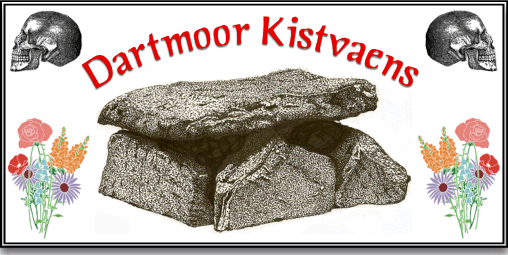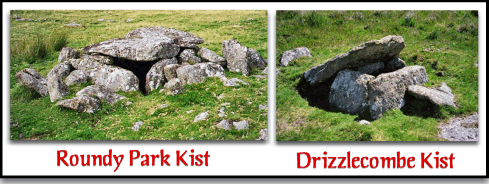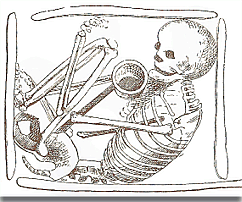
Attempting to even try to explain burial tombs which are around 4,000 years old is virtually impossible and full of modern-day conjectures and beliefs. Clearly the very design of ancient tombs had some significance and meaning to the prehistoric mind but trying to say exactly what is impossible.
It has been estimated that the population of Dartmoor in the Bronze Age was between eight and nine thousand people. Since the early antiquarians began their work on the moor around about 200 hundred burial tombs have been found. Accepting the fact that many of them have been destroyed and that there are some still to be discovered this is a disproportionate number compared to the estimate population. Could this then suggest that it was only the more influential or ruling classes that were being buried in stone tombs?
So to begin with what are these tombs called, generally they are referred to as cists although on Dartmoor there is often mention of kistvaens or kists. It is thought that the word kistvaen has derived from the Celtic cist (chest) and maen (stone) aptly meaning ‘stone chest’ although how the letter ‘k’ came to be used I know not.
The accepted description of a ‘typical’ Dartmoor kist is that it comprises of a four-sided stone chest with a covering slab and occasionally a paved floor. They were constructed of stone, mostly granite, because presumably there was a plentiful supply on the moor. The majority were dug into the sub-soil so that the top edges of the side slabs were flush with the surface level. There kists come in a large range of sizes which vary from one of the largest at Roundy Park to the fairly small at Drizzlecombe. Although it is estimated than an average sized kist would be about 1 – 1.5m long, 0.6m wide, and 0.6m deep.

Others were raised up and appeared to have been free-standing on the ground as at Roundy Park. Once completed the kists were then covered with a mound of earth or a cairn of stones, and there seems to be no evidence to suggest that the capstone remained uncovered. Many kists were surrounded by a retaining or kerb circle of upright stones which tended to be very small on insignificant. Some instances of kists are associated with other ritual features such as the ones that occur at the terminals of stone rows. As far as locations go it is difficult to establish a norm as they can be found anywhere, ranging from hilltops to beside riverbanks. One feature unique to the Dartmoor kists is that the majority tend to have their lengths orientated on a NW/SE axis, it is estimated that 94% of the known kists conform to this rule.

There were two main methods of interring the deceased, either the body was placed into the stone chamber in a crouched foetal position or the remains were cremated and the ashes placed in an urn and interred in the floor of the pit. Due to the acidity of the peaty soil many of the remains have been lost along with any perishable grave goods thus making it difficult to reach any firm conclusion as to the exact funerary rites. When bones are burnt it tends to make them more resistant to the acidic effects of the peat and in this light evidence for cremation has been found at 16 excavated cairns. About 53 excavated cairns have revealed grave good which were buried with the human remains. These include flint tools, flint arrowheads, pottery, quartz crystals, dress fasteners, glass beads, cooking stones, stone hammers, a stone amulet, bronze knives, bronze spearheads, a dagger pommel, and faience beads. Many of these finds are dateable to the Early Bronze Age which ran from about 2300 – 1400BC.
Once completed the buried kistvaen with its cover cairn of stones must have been an impressive accomplishment. Not only did it demonstrate a purpose of belief and ritual it also indicated a social structure capable of organisation as these structures were not simply ‘thrown up’ overnight. Where groups of cairns were built it also indicated a permanency in settlement patterns insomuch as the early dwellers were in effect building cemeteries close to their dwellings. The general consensus is that where a cluster of 5 or more burial mounds are found this is in effect a ‘cairn cemetery’. These also suggest that the site was in use for several generations which again points to a settled population.
But apart from the obvious burial aspects what did the cairns and their kists mean to their builders? One field of thought is that the ‘prestige cairns’ (those with a diameter larger than 20m) were designed to project the status and importance of the associated settlements. This was done by building them at impressive locations where they would be clearly visible from great distances. Also the monuments would also provide a statement which said, “this land is occupied and controlled”, they would also give a sense of social identity and cohesion to the local people. In some respects the cairns would also have acted as territory markers and the very fact that people were buried under them would have suggested a well settled and organised community.
Unfortunately, down through the centuries the kists became associated with buried ‘treasure’ which in a sense was correct. Where the problem arose was that what Bronze Age man regarded as treasure was such things as flint arrowheads, beads, and quartz crystals and so the precious possessions were buried along with the departed. Later man, the tomb raider, then went in search of this ‘treasure’ expecting to find hoards of gold and in the process ransacked many of the kists. Obviously what he found must have been a huge disappointment and his prospects of ‘get rich quick’ greatly diminished as flint arrowheads were worthless. Ironically, today, the very things the despoiler was finding and discarding would be regarded as priceless along with the information they could now impart. In 2011 a kist was excavated on Whitehorse Hill and was found to be intact with all its ‘treasures’ in situ which admirably proves my point, had this been found centuries ago by the treasure seekers then the grave goods would have been considered as worthless. However, in the 21st century these valuable artefacts have given us a ‘trove’ of information on life in the Bronze Age and the buried rituals applicable at the time.

Baring Gould, S. 1982. A Book of Dartmoor. London: Wildwood House Ltd.
Clark Hall, J. R. 2004 A Concise Anglo-Saxon Dictionary, Canada: Cambridge University Press.
 Legendary Dartmoor The many aspects past and present of Dartmoor
Legendary Dartmoor The many aspects past and present of Dartmoor

One comment
Pingback: Year 2 Final Major Project – Bibliography – ED3GAM1F – Luke Ford Blog